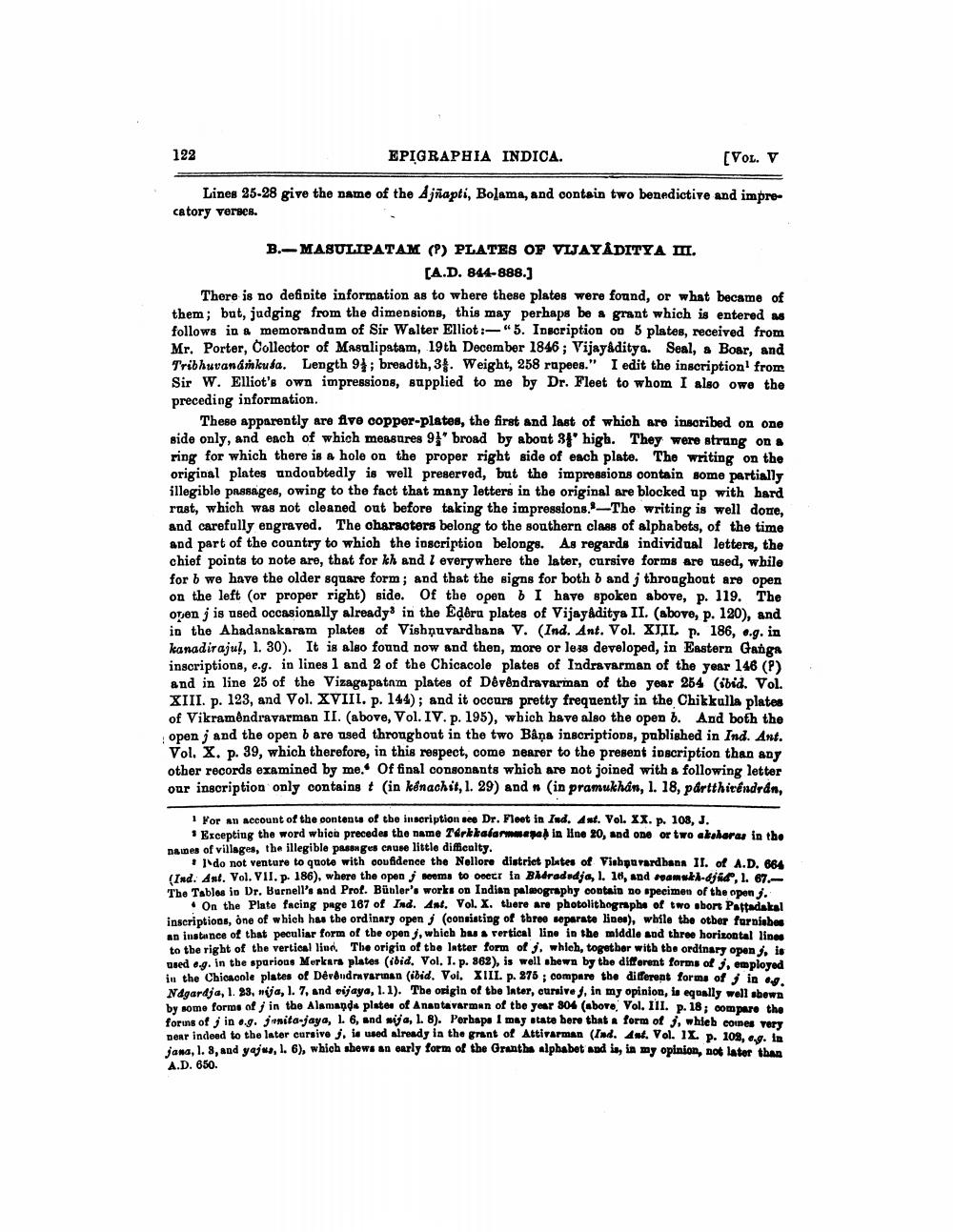________________
122
EPIGRAPHIA INDICA.
(VOL. V
Lines 25-28 give the name of the Ajñapti, Bolama, and contain two benedictive and imprecatory verses.
B.-MASULIPATAM (P) PLATES OF VIJAY ADITYA M.
(A.D. 844-888.) There is no definite information as to where these plates were found, or what became of them; but, judging from the dimensions, this may perhaps be a grant which is entered as follows in & memorandum of Sir Walter Elliot:-“5. Inscription on 5 plates, received from Mr. Porter, Collector of Masulipatam, 19th December 1846 ; Vijayaditya. Seal, a Boar, and Tribhuvandikuda. Length 9; breadth, 34. Weight, 258 rupees." I edit the inscription from Sir W. Elliot's own impressions, supplied to me by Dr. Fleet to whom I also owe the preceding information.
These apparently are five copper-plates, the first and last of which are inscribed on one side only, and each of which measures 91' broad by about 81' high. They were strong ons ring for which there is a hole on the proper right side of each plate. The writing on the original plates andoabtedly is well preserved, but the impressions contain some partially illegible passages, owing to the fact that many letters in the original are blocked up with hard rast, which was not cleaned out before taking the impressions. The writing is well done, and carefully engraved. The characters belong to the southern class of alphabets, of the time and part of the country to which the inscription belongs. As regards individual letters, the chief points to note are, that for kh and I everywhere the later, cursive forms are used, while for b we have the older square form; and that the signs for both b and j throughout are open on the left (or proper right) side. Of the open b I have spoken above, p. 119. The open j is used occasionally already in the Edbru plates of Vijayaditya II. (above, p. 120), and in the Ahadanakaram plates of Vishnuvardhana V. (Ind. Ant. Vol. XIIL p. 186, e.g. in kanadirajul, 1. 30). It is also found now and then, more or less developed, in Eastern Ganga inscriptions, e.g. in lines 1 and 2 of the Chicacole plates of Indravarman of the year 146 () and in line 25 of the Vizaga patnm plates of Dêvêndravarman of the year 254 (ibid. Vol. XIII. p. 123, and Vol. XVIII. p. 144); and it occurs pretty frequently in the Chikkulla plates of Vikramêndravarman II. (above, Vol. IV. p. 195), which have also the open b. And both the open j and the open b are used throughout in the two Båņa inscriptions, published in Ind. Ant. Vol. X. p. 39, which therefore, in this respect, come nearer to the present inscription than any other records examined by me. Of final consonants which are not joined with a following letter our inscription only contains t (in kenachit, 1. 29) and (in pramukhan, 1. 18, pártthitendrán,
For an account of the contents of the inscription see Dr. Fleet in Ind. Ant. Vol. XX. p. 108, J.
* Excepting the word which precedes the name Tarkkalawwepa in Mne 20, and one or two akaharas in the names of villages, the illegible passages enure little difficulty.
I do not venture to quote with coufidence the Nellore district plates of Vishpavardhana II. of A.D. 164 (Ind. Ant. Vol. VII. p. 186), where the open sooms to oeeer in Badradedja, I. 14, and ramuk-djad, 1. 67.The Tables in Dr. Burnell's and Prof. Bünler's works on Indian palmography contain no specimen of the open j.
On the Plate facing page 167 of Ind. Ant. Vol. X. there are photolithographs of two short Pattadakal inscriptions, one of which has the ordinary open y consisting of three separate line), while the other furniabos an instance of that peculiar form of the open y, which has a rertical line in the middle and three horizontal lines
to tbe right of the vertical lion. The origin of the latter form of j. whleh, together with the ordinary open s. is used 9. in tbe sparions Merkers plates (ibid. Vol. 1. p. 862), is well shewn by the different forms of j, employed in the Chicacole plates of Dêrêudrugarian (ibid. Vol. XII. p. 876 ; compare the different forms of ; in a Ndgardja, 1. 23, nija, 1. 7, and vijaya, 1.1). The origin of the Inter, cursive , in my opinion, is equally well sbow by some forms of in the Alamande plates of Anantavarman of the year 804 (above, Vol. III. p. 18; compare the foring of jino.g. genita-jaya, L. 6, and mija, L. 8). Perhaps I may state bere that a form of s, whleb connes very nerr indeed to the later cursive J. To used already in the grant of Attivarman (Ind. And, Vol. IX. p. 108 jana, 1. 8, and yajus, 1. 6), which shows an early form of the Grantha alphabet and is, in my opinion, not later than A.D. 650.




